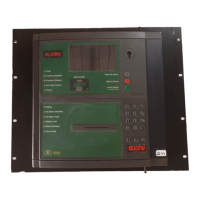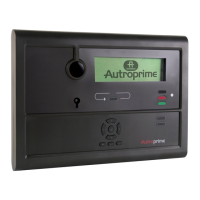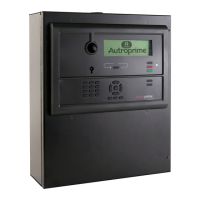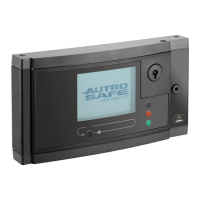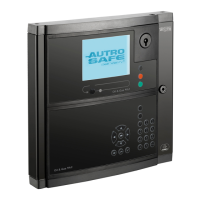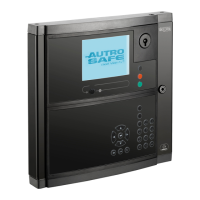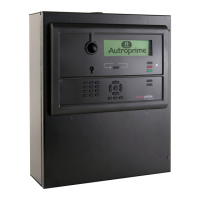
Do you have a question about the Autronica Autroprime and is the answer not in the manual?
| Brand | Autronica |
|---|---|
| Model | Autroprime |
| Category | Fire Alarms |
| Language | English |
Defines the scope and purpose of the operator's handbook.
Identifies the intended audience and required prior knowledge.
Lists supplementary technical documentation available for the system.
Details the system's hardware components and their interconnections.
Introduces the operator panel and its integration within the system.
Explains the function of various indicators on the operator panel.
Describes the features and functionality of the operator panel's display.
Introduces and describes the various buttons on the operator panel.
Describes the activation and silencing of the panel's internal buzzer.
Explains how system loop topology is displayed on the panel.
Describes the panel's appearance and state when not actively used.
Lists the various system states or conditions (e.g., alarm, fault).
Details the different levels of alarm detection from detectors.
Explains the three distinct user access levels for panel operation.
Illustrates how alarm events are displayed on the operator panel.
Guides the user on how to access detailed information about specific events or points.
Describes how the internal buzzer is managed.
Describes silencing fire alarm devices.
Introduces the various sources from which system components can be disabled.
Discusses how detection zones are organized and managed for alarm processing.
Reference to the chapter detailing fire alarm procedures.
Reference to the chapter covering fire alarms with delay.
Reference to the chapter describing pre-alarm events.
Reference to the chapter covering system fault conditions.
Reference to the chapter on supervisory events.
Describes the visual and audible indicators during a fire alarm event.
Provides step-by-step instructions for responding to a fire alarm.
Describes the indicators and display messages for a pre-alarm event.
Provides step-by-step instructions for responding to a pre-alarm.
Details the indicators present when a fire alarm has an active delay.
Provides step-by-step instructions for handling fire alarms with an active delay.
Describes the indicators and display messages for system fault conditions.
Provides step-by-step instructions for addressing system faults.
Describes the indicators for supervisory events, such as door unit activation.
Provides step-by-step instructions for responding to supervisory events.
Explains the organization and navigation of the system's menu structure.
Guides the user on how to access the main menu from operation mode.
Details the procedure for entering the system's service mode.
Introduces the system status menu and its purpose.
Lists the various status conditions that can be viewed in the menu.
Provides an example of how to view alarm status within the system status menu.
Introduces the functionality for disabling system components.
Outlines the different components that can be disabled via the menu.
Explains the process and effect of disabling active or inactive components.
Details how to disable entire detection zones and their points.
Explains how to disable alarm zones and associated fire alarm devices.
Describes how to disable individual detection points like detectors or call points.
Explains how to disable specific Fire Alarm Devices (FADs).
Details how to disable system outputs controlling equipment.
Explains how to disable system inputs receiving signals.
Describes how to disable routing equipment like FARE/FWRE.
Explains how to disable Loop IO Carriers.
Provides a step-by-step example of disabling a detection zone.
Introduces the functionality for enabling system components.
Lists the components available for enabling in the menu.
Explains how to re-enable components that were previously disabled.
Details how to enable detection zones and their points.
Explains how to enable alarm zones and associated devices.
Describes how to re-enable individual detection points.
Details how to enable specific Fire Alarm Devices (FADs).
Explains how to enable system outputs.
Describes how to enable system inputs.
Explains how to enable routing equipment.
Details how to enable Loop IO Carriers.
Provides an example of executing commands within the enable menu.
Explains how to enable or disable all system delays.
Introduces the menu for viewing properties of system units.
Lists the different types of units whose properties can be viewed.
Shows how to view the properties of detection zones.
Shows how to view the properties of alarm zones.
Shows how to view the properties of individual points.
Shows how to view the properties of fire alarm devices.
Shows how to view the properties of loop outputs.
Shows how to view the properties of local outputs.
Shows how to view the properties of loop inputs.
Shows how to view the properties of local inputs.
Shows how to view the properties of loop IO carriers.
Shows how to view the properties of mimic panels.
Shows how to view the properties of activation groups.
Lists the different types of external interfaces supported by the system.
Shows how to view the properties of detection loops.
Shows how to view the properties of operator panels.
Introduces the report menu and its submenus.
Lists the available report options within the menu.
Explains how to access and analyze system event logs.
Describes how to view the system's network topology.
Shows how to display the current system date and time.
Displays information about the system's software version.
Displays information about the system's configuration version.
Introduces service commands and the required access levels.
Outlines the structure and capabilities of the service menu.
Explains how to perform manual tests on detection zones.
Explains how to perform manual tests on alarm zones.
Explains how to perform individual tests on fire alarm devices.
Explains how to perform tests on loop outputs.
Explains how to perform tests on local outputs.
Refers to the appendix for a detailed menu structure diagram.
